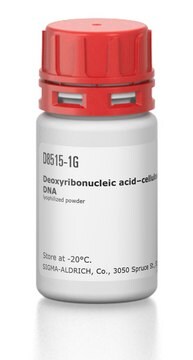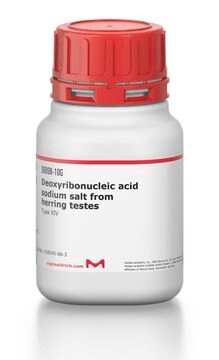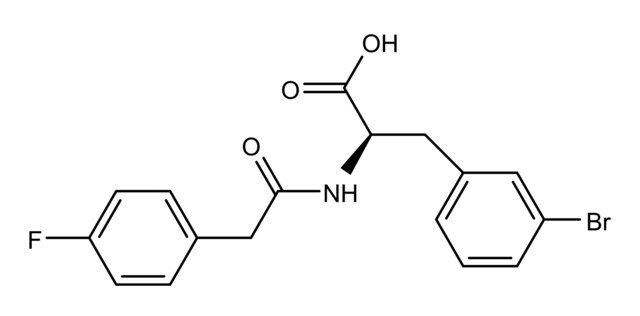D1501
Deoxyribonucleic acid sodium salt from calf thymus
Type I, fibers
Synonyme(s) :
ctDNA, DNA sodium salt from calf thymus, Thymonucleic acid sodium salt
About This Item
Produits recommandés
Vous recherchez des produits similaires ? Visite Guide de comparaison des produits
Application
Qualité
Propriétés physiques
DNA from calf thymus is 41.9 mole % G-C and 58.1 mole % A-T.1 An OD of 1.0 at 260 nm corresponds to ~ 50 μg of double-stranded DNA.
Forme physique
Notes préparatoires
Reconstitution
Code de la classe de stockage
11 - Combustible Solids
Classe de danger pour l'eau (WGK)
WGK 3
Point d'éclair (°F)
Not applicable
Point d'éclair (°C)
Not applicable
Équipement de protection individuelle
Eyeshields, Gloves, type N95 (US)
Certificats d'analyse (COA)
Recherchez un Certificats d'analyse (COA) en saisissant le numéro de lot du produit. Les numéros de lot figurent sur l'étiquette du produit après les mots "Lot" ou "Batch".
Déjà en possession de ce produit ?
Retrouvez la documentation relative aux produits que vous avez récemment achetés dans la Bibliothèque de documents.
Les clients ont également consulté
Protocoles
Enzymatic Assay of Nuclease S1, Product No. N5661
Notre équipe de scientifiques dispose d'une expérience dans tous les secteurs de la recherche, notamment en sciences de la vie, science des matériaux, synthèse chimique, chromatographie, analyse et dans de nombreux autres domaines..
Contacter notre Service technique














